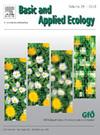鲜花盛开的道路边缘增加了周围景观中赏花游客的数量
IF 3.5
2区 环境科学与生态学
Q2 ECOLOGY
引用次数: 0
摘要
由于栖息地的丧失和恶化,访花昆虫和依赖它们的植物正在减少。道路边缘通常提供丰富的花卉资源,其潜在的保护价值正受到关注,因为它们可以支持高丰度和多样性的访花昆虫。因此,花朵丰富的道路边缘可能有利于周围景观的授粉。然而,交通对这一效益的潜在负面影响仍未得到探讨。我们使用盆栽野生草莓植物(Fragaria vesca,品种“r本文章由计算机程序翻译,如有差异,请以英文原文为准。
Flower-rich road verges increase abundance of flower visitors in the surrounding landscape
Flower-visiting insects and the plants that depend on them are declining due to habitat loss and deterioration. Road verges, which often provide abundant floral resources, are gaining attention for their potential conservation value, as they can support a high abundance and diversity of flower-visiting insects. Thereby, flower-abundant road verges may benefit pollination in surrounding landscapes. However, the potential negative effect of traffic on this benefit remains unexplored. We addressed the research gap using potted wild strawberry plants (Fragaria vesca, variety ‘Rügen’), placed at 20 m and 80–100 m distance from road verges along roads with varying traffic intensity (around 100–5500 vehicles per day). We found that floral abundance in road verges enhanced the number of flower visitors to strawberry plants in nearby areas, regardless of the distance to the road verge. However, this positive effect was restricted by increasing traffic intensity and narrower road verge width. Despite similar numbers of flower visitors at both distances, the pollination success, measured as the number of developed achenes on each harvested strawberry, tended to be lower closer to the road verge than further away but was unrelated to flower density, traffic intensity and road verge width, which indicates potential differences in pollinator behaviour or in the pollen they carried. Our findings highlight the potential of flower-rich road verges to support the conservation of flower-visiting insects. However, we emphasise the need to consider road verge width and traffic intensity to ensure successful pollinator-friendly management.
求助全文
通过发布文献求助,成功后即可免费获取论文全文。
去求助
来源期刊

Basic and Applied Ecology
环境科学-生态学
CiteScore
6.90
自引率
5.30%
发文量
103
审稿时长
10.6 weeks
期刊介绍:
Basic and Applied Ecology provides a forum in which significant advances and ideas can be rapidly communicated to a wide audience. Basic and Applied Ecology publishes original contributions, perspectives and reviews from all areas of basic and applied ecology. Ecologists from all countries are invited to publish ecological research of international interest in its pages. There is no bias with regard to taxon or geographical area.
 求助内容:
求助内容: 应助结果提醒方式:
应助结果提醒方式:


